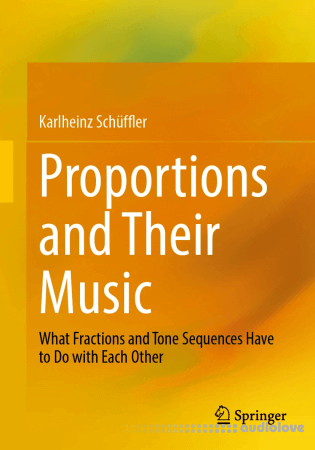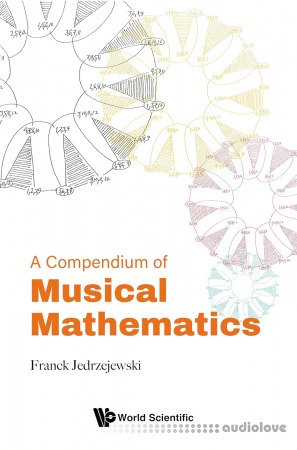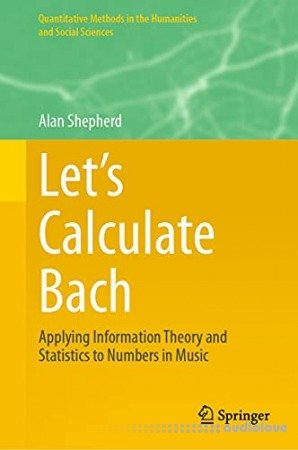Proportions and Their Music: What Fractions and Tone Sequences Have to Do with Each Other

English | 2024 | ISBN: 978-3-662-65336-4 | 273 Pages | EPUB PDF (True) | 16 MB
Sounds can be harmonic, number sequences too - a coincidence?
This book deals with a musical theory of proportions, i.e. the ancient doctrine of proportions as the oldest and most important common anchorage of the two cultural sciences mathematics and music.
The musical theory of tones, intervals, tetrachords, sounds and scales is in fact the exact musical image of the laws of arithmetic and its symmetries in the set of rules of playing with numbers, their proportions and their medievals. Alone the miracle of the so-called Harmonia perfecta maxima 6 - 8 - 9 - 12, whose proportions determine the fifth as well as the fourth, form the octave and have the brazen whole tone in their center, shaped the musical edifice of Pythagorean music for thousands of years. This elementary chain of proportions 6 : 8 : 9 : 12 is, moreover, completely symmetrical and built up from the arithmetic as well as from the harmonic medieta of the octave numbers 6 and 12.
This book develops the theory of proportions as a mathematical science and always contrasts it with the musical motivation by means of numerous examples. The main idea is the derivation of a theory of symmetry from the Harmonia perfecta maxima to the Harmonia perfecta infinita abstracta, a process of unlimited tone generations by Babylonian mean iterations. From this, both the classical-antique diatonic is simultaneously extracted and the path "from the monochord to the organ" is re-examined.
Finally, the work contains a mathematically guided introduction to the ancient tetrachordics as well as to the church tonal scales and concludes with an excursion into the sound worlds of the organ. Here the "foot-number rule of the organ" leads us by means of examples into the world of the tonal dispositions of this instrument and shows the omnipresence of the ancient theory of proportions.
This book is suitable for anyone with an interest in mathematics and music.
This book is a translation of the original German 1st edition Proportionen und ihre Musik by Karlheinz Schüffler, Springer-Verlag GmbH Germany, part of Springer Nature in 2019. The translation was done with the help of artificial intelligence (machine translation by the service DeepL.com). A subsequent human revision was done primarily in terms of content, so that the book will read stylistically differently from a conventional translation. Springer Nature works continuously to further the development of tools for the production of books and on the related technologies to support the authors.
home page:
https://goo.su/Yu7uN
DOWNLOAD
Related News:
 A Compendium of Musical Mathematics
A Compendium of Musical MathematicsEnglish | 2024 | ISBN: 9811284369 | 286 pages | True PDF | 9 MB The purpose of this book is to provide a concise introduction to the mathematical theory of music, opening each chapter to the most recent research. Despite the complexity of some sections, the book can be read by a large audience. Many examples illustrate the concepts introduced. The book is divided into 9 chapters....
 Let’s Calculate Bach: Applying Information Theory and Statistics to Numbers in Music
Let’s Calculate Bach: Applying Information Theory and Statistics to Numbers in MusicEnglish | 2021 | ISBN: 3030637689 | 372 pages | pdf, epub | 49 MB This book shows how information theory, probability, statistics, mathematics and personal computers can be applied to the exploration of numbers and proportions in music. It brings the methods of scientific and quantitative thinking to questions like: What are the ways of encoding a message in music and how can we be sure of the...
 Scales & Music Theory: Learn Scales And The Theory Behind Them And Give Yourself A Huge Advantage
Scales & Music Theory: Learn Scales And The Theory Behind Them And Give Yourself A Huge AdvantageEnglish | 2016 | ISBN: N/A | ASIN: B01AF0649K | 78 pages | PDF | 1 MB Learn musical scales and the theory behind them, and give yourself a huge advantage. This book will teach you how to form the most important musical scales. It will also teach you the theory behind scales, and this will give you a BIG advantage as a player....
 Music Theory: A Practical Approach to Quickly Understand the Theory in a Step-By-Step Way. Learn How to Read And Compose Melody
Music Theory: A Practical Approach to Quickly Understand the Theory in a Step-By-Step Way. Learn How to Read And Compose MelodyEnglish | 2020 | ISBN-13 : 979-8671284546 | 186 Pages | PDF, EPUB, AZW3 | 17.95 MB Have you ever had trouble learning music theory or thought that it's too hard to learn? Do you want to learn music theory and master scales and chords? Can you imagine your friend’s surprise when you will get to entertain them playing their favorite songs? If yes, then keep reading....
Comments for Proportions and Their Music: What Fractions and Tone Sequences Have to Do with Each Other:
No comments yet, add a comment!